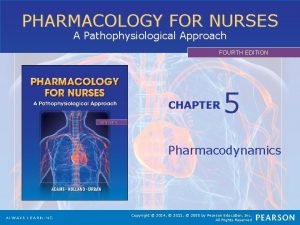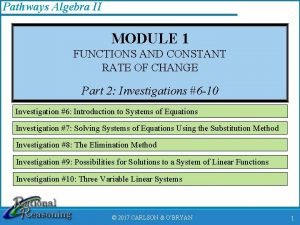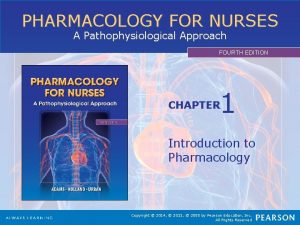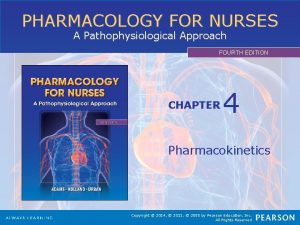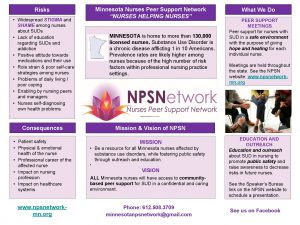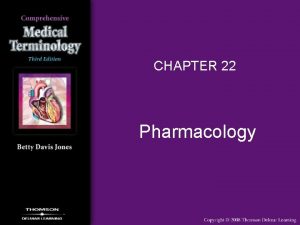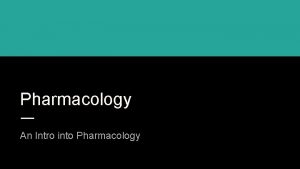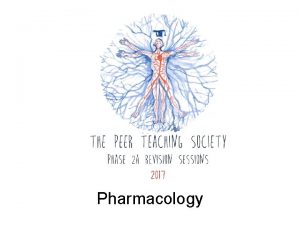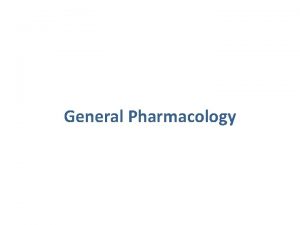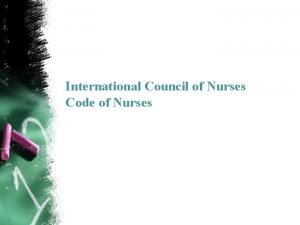PHARMACOLOGY FOR NURSES A Pathophysiological Approach FOURTH EDITION
















- Slides: 16

PHARMACOLOGY FOR NURSES A Pathophysiological Approach FOURTH EDITION CHAPTER 5 Pharmacodynamics Copyright © 2014, © 2011, © 2008 by Pearson Education, Inc. All Rights Reserved

Pharmacodynamics and Clinical Practice • Pharmacodynamics – how a medicine changes the body • Helps to predict if drug will produce change • Will ensure that drug will provide safe, effective treatment • Combination of drug guides and intuitive knowledge will guide safe treatment Pharmacology for Nursing: A Pathophysiology Approach , Fourth Edition Michael Patrick Adams | Leland N. Holland | Carol Urban

Skill of Nurse Critical in Determining if Average Dose Is Effective • Patient observation • Taking of vital signs • Monitoring lab data Pharmacology for Nursing: A Pathophysiology Approach , Fourth Edition Michael Patrick Adams | Leland N. Holland | Carol Urban

Drugs That Act as Agonists • Bind to receptor • Produce same response as endogenous substance • Sometimes produce greater maximal response Pharmacology for Nursing: A Pathophysiology Approach , Fourth Edition Michael Patrick Adams | Leland N. Holland | Carol Urban

Drug Attaches to Receptor • Like key to lock • May trigger second messenger events – e. g. , activation of specific G proteins and associated enzymes • Initiates drug action • Can stimulate or inhibit normal activity Pharmacology for Nursing: A Pathophysiology Approach , Fourth Edition Michael Patrick Adams | Leland N. Holland | Carol Urban

Drugs That Act as Partial Agonists • Bind to receptor • Produce weaker response than agonists Pharmacology for Nursing: A Pathophysiology Approach , Fourth Edition Michael Patrick Adams | Leland N. Holland | Carol Urban

Drugs That Act as Antagonists • Occupy receptor • Prevent endogenous chemical from acting • Often compete with agonists for receptor • Functional antagonists inhibit the effects of an agonist not by competing for a receptor, but by changing pharmacokinetic factors. Pharmacology for Nursing: A Pathophysiology Approach , Fourth Edition Michael Patrick Adams | Leland N. Holland | Carol Urban

Therapeutic Index • Measure of a drug's safety margin • The higher the value, the safer the drug Pharmacology for Nursing: A Pathophysiology Approach , Fourth Edition Michael Patrick Adams | Leland N. Holland | Carol Urban

Calculating Therapeutic Index Pharmacology for Nursing: A Pathophysiology Approach , Fourth Edition Michael Patrick Adams | Leland N. Holland | Carol Urban

Example of Therapeutic Index • Therapeutic index of 4: need error four times dose to be lethal Pharmacology for Nursing: A Pathophysiology Approach , Fourth Edition Michael Patrick Adams | Leland N. Holland | Carol Urban

Figure 5. 2 Therapeutic index: (a) drug X has a therapeutic index of 4; (b) drug Z has a therapeutic index of 2 Pharmacology for Nursing: A Pathophysiology Approach , Fourth Edition Michael Patrick Adams | Leland N. Holland | Carol Urban

Two Ways to Compare Medications • Potency • Efficacy Pharmacology for Nursing: A Pathophysiology Approach , Fourth Edition Michael Patrick Adams | Leland N. Holland | Carol Urban

Potency • Drug with higher potency produces a therapeutic effect at a lower dose, compared with another drug in the same class. Pharmacology for Nursing: A Pathophysiology Approach , Fourth Edition Michael Patrick Adams | Leland N. Holland | Carol Urban

Efficacy • Magnitude of maximal response that can be produced from a particular drug • From a pharmacotherapeutic perspective, efficacy is almost always more important than potency. Pharmacology for Nursing: A Pathophysiology Approach , Fourth Edition Michael Patrick Adams | Leland N. Holland | Carol Urban

Figure 5. 4 than drug B Potency and efficacy: (a) drug A has a higher potency than drug B; (b) drug A has a higher efficacy Pharmacology for Nursing: A Pathophysiology Approach , Fourth Edition Michael Patrick Adams | Leland N. Holland | Carol Urban

In the Future: Customized Drug Therapy • End of single-drug, one-size-fits-all policy • DNA test before receiving drug • Prevention of idiosyncratic responses— unpredictable and unexplained drug reactions • Pharmacogenetics—area of pharmacology that examines role of heredity in drug response Pharmacology for Nursing: A Pathophysiology Approach , Fourth Edition Michael Patrick Adams | Leland N. Holland | Carol Urban
 Pharmacology for nurses: a pathophysiological approach
Pharmacology for nurses: a pathophysiological approach Expert systems: principles and programming, fourth edition
Expert systems: principles and programming, fourth edition Ethics in information technology 6th edition answers
Ethics in information technology 6th edition answers Project 2 fourth edition
Project 2 fourth edition Vertical line html
Vertical line html Pathways algebra 2 fourth edition answer key
Pathways algebra 2 fourth edition answer key Discrete mathematics with applications fourth edition
Discrete mathematics with applications fourth edition Ethics in information technology fourth edition
Ethics in information technology fourth edition Using mis (10th edition) 10th edition
Using mis (10th edition) 10th edition Zulily case study
Zulily case study Computer architecture a quantitative approach sixth edition
Computer architecture a quantitative approach sixth edition Fifth edition chemistry a molecular approach
Fifth edition chemistry a molecular approach Computer architecture a quantitative approach sixth edition
Computer architecture a quantitative approach sixth edition Cognitive theory child development
Cognitive theory child development Computer architecture a quantitative approach sixth edition
Computer architecture a quantitative approach sixth edition Computer architecture a quantitative approach 5th edition
Computer architecture a quantitative approach 5th edition Annual review of pharmacology and toxicology
Annual review of pharmacology and toxicology
